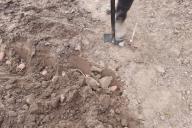Raspberries are a favorite berry for many, but growing them can be a real challenge due to pests.
Some of the most insidious are bugs, capable of causing serious damage to crops in a short time. Fighting these insects requires a comprehensive approach and patience.
Problem identification
Before you begin to deal with bed bugs, it is important to make sure that they are the cause of the problems on your raspberry bushes.
The bugs are usually small, about 4-5 mm, have a characteristic shield shape and can be of different colors - from green to brown. They feed on plant sap, which leads to deformation of berries and leaves.
Preventive measures
Prevention is the key to a healthy raspberry patch. Regularly removing fallen leaves and dry branches where bugs can overwinter significantly reduces their population.

It is also important to maintain an optimal distance between bushes for good ventilation, which creates less favorable conditions for the reproduction of pests.
Folk methods of struggle
Many gardeners prefer to begin the fight against bedbugs using folk remedies.
One of the effective methods is spraying the bushes with an infusion of garlic or onion.
To prepare the solution, you need to chop 200 grams of garlic or onion, pour a liter of water and leave for 24 hours. Then filter the solution and dilute it with water in a ratio of 1:10 before use.
Using repellent plants
Some plants have bug-repelling properties. Planting marigolds, calendula, or mint near raspberry bushes can help control the pests.
These plants not only repel insects, but also attract beneficial pollinators.
Biological methods
Biological control methods include the use of natural enemies of bedbugs.
Attracting birds such as tits or starlings to your garden can significantly reduce pest populations. Installing birdhouses and bird feeders will help attract these natural helpers.
Insecticide treatments
If natural methods do not produce the desired results, the use of insecticides may be required.
It is important to choose preparations approved for use on berry crops and strictly follow the instructions for use. It is better to carry out treatment in the evening, when insect activity decreases.
Mechanical methods
Mechanical control methods involve hand-picking the bugs and their eggs. Although this is a labor-intensive process, it can be effective on small plant populations.
Bedbugs can be shaken off onto a cloth spread under the bushes early in the morning when they are less active.
Improving the overall health of plants
Healthy, strong plants are better able to resist pest attacks. Regular watering, adding organic fertilizers and mulching the soil help strengthen the immunity of raspberries.
Strong plants are less attractive to bugs and tolerate their presence better.
Sanitary pruning
Timely and correct pruning of raspberry bushes not only improves yield, but also helps in the fight against pests.
Removing old, damaged and excess shoots improves air circulation in the bush, which creates less favorable conditions for the reproduction of bugs.
Regular monitoring
Constant monitoring of the condition of raspberry bushes allows you to notice the appearance of pests in time and take action before the problem becomes serious.
Regular inspection of leaves and shoots, especially during the period of berry formation, will help to detect bugs in time and prevent their mass reproduction.








